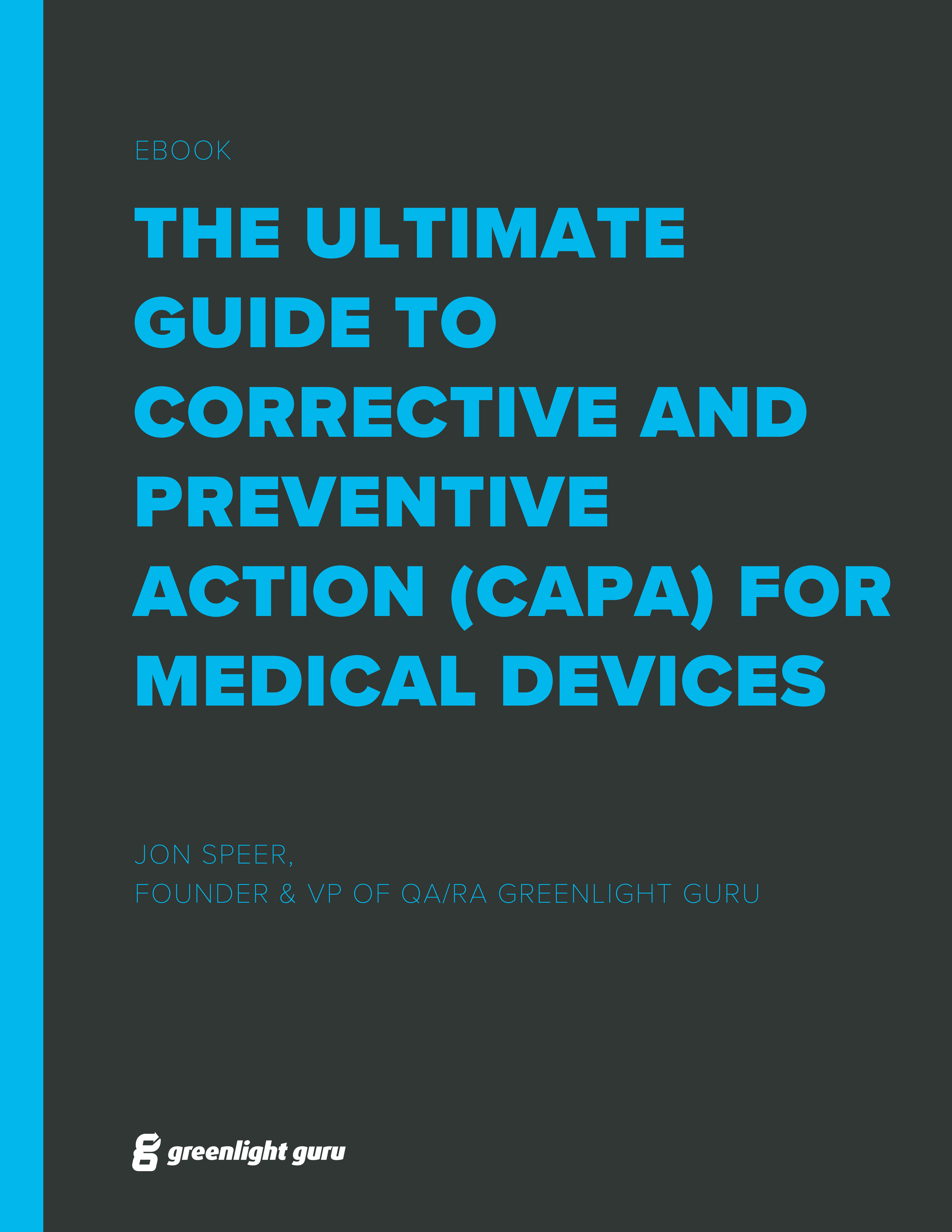
They say eyes are the windows to our innermost selves. If that’s true, then the same should be said for your corrective and preventive action (CAPA) process and the view it provides into the effectiveness of your quality management system (QMS).
And just as important as the steps that make up the CAPA process, so too are the different CAPA phases that flow into one another. When these phases are disconnected or done poorly, the results can be disastrous. In our 2022 State of Medical Devices Report, we found that only 17% of respondents felt their company’s understanding of CAPA was rated excellent.
Breakdown of the 5 CAPA phases
With that in mind, we decided to take a closer look at an aspect of CAPA that often goes overlooked: managing and perfecting the CAPA phases.
CAPA Phase 0: Preparation
Preparation is an essential step to any successful CAPA system. In order for the CAPA process to be effective, your team needs to have the proper CAPA forms, SOPs, and instructions in place. And all of this starts with your CAPA procedures document, the detailed guidelines for your organization’s approach to managing CAPA.
CAPA procedures define the objectives, criteria, steps, and responsibilities of a CAPA system, and serve as both an internal reference and formal documentation for regulatory bodies. In fact, missing or inadequate CAPA procedures is one of the most commonly cited reasons for FDA 483 observations and warning letters.
Your CAPA procedures document should contain the following sections:
-
An overview of the CAPA procedures, including the scope, purpose, involved personnel, and list of external resources referenced in the document.
-
Definitions of terms, like “corrective action,” “incident,” or “nonconforming product.”
-
CAPA process flow, which lays out steps to the CAPA process and how it advances through each phase.
-
CAPA forms to be completed when events occur, and as the investigation proceeds. This is your documentation and should be centralized.
-
Additional information explaining the role of management in the review process.
Once you’ve crafted your CAPA procedures document, be sure to get input from all relevant stakeholders to ensure total coverage.
CAPA Phase 1: Identification and assessment
The first CAPA phase is all about identification of an issue, a review of its risk level and potential impact, and a decision as to whether or not the event is deserving of a formal CAPA investigation.
The CAPA process begins when an issue is observed during or after the manufacturing of a medical device. These observations can come from a variety of inputs, including:
-
Nonconforming (NC) product or process
-
Customer complaints
-
Internal or external review
-
Clinical trials
-
Validation activities
-
Management review
Upon observation, events should be submitted as a CAPA request, which outlines the possible CAPA data and sources, as well as who or where the input comes from. This step should include as much information as possible, as it will serve as the basis of the risk assessment. Requests should be categorized as either high, medium, or low risk before being reviewed by a quality review board (QRB) or quality manager.
Companies often struggle to understand what should or shouldn’t trigger a CAPA investigation. Remember—your CAPA process is meant to investigate and address systemic quality issues, such as a component that repeatedly fails inspections during manufacturing. So, in addition to assessing the risk to users or regulatory compliance, it’s a good idea to consider whether this event has occurred in the past or points to a larger underlying problem.
If the event is rejected, be sure to document the reasoning, enact any corrections that may be needed, and monitor for future issues. If the event is accepted as a CAPA, it should be documented, issued a tracking or reference number, and moved forward into the next CAPA phase.
CAPA Phase 2: Root cause analysis
The second CAPA phase is where the investigation truly begins. You’ll be breaking down the factors and conditions that led to the issue, and methodically peeling back layers to uncover the root cause of the problem and, ultimately, a permanent solution.
Before delving into data, there are two pressing needs that must be fulfilled upfront.
The first is determining if any immediate actions or corrections are needed for containment, such as quarantining a nonconforming product or issuing a product recall.
The second need is to create a cross-functional team for your CAPA investigation. By definition, CAPA events are never isolated, so the goal here should be to involve as many sources across the organization as necessary. Ultimately, there will need to be a final say from management, like your QRB or quality manager.
The CAPA investigation should take the form of a root cause analysis, a method of problem-solving that systematically reveals the underlying source of an issue. This process can be done thoroughly with the use of various root cause analysis methodologies, including:
-
The Five Whys
-
Cause And Effect Analysis (Fishbone/Ishikawa Diagram)
-
Fault Tree Analysis
-
Pareto Chart
-
Scatter Diagram
However you choose to perform the root cause analysis, remember to keep digging deeper and deeper, as you continue to uncover key causal factors. Don’t stop until you have discovered the fundamental cause for the problem at hand.
And, as the old credo goes: “If you didn’t document it, it didn’t happen,” so be sure to compile all findings, data, interviews, and other relevant information in your risk management file for easy reference.
CAPA Phase 3: Implementation
With the root cause determined, and your findings documented, you should have everything you need to start implementing the corrective and preventive actions to address your CAPA event.
In order to do so, you’ll need to begin developing a thorough action plan for correcting the immediate issue, as well as the long-term solutions that will prevent the issue from happening again. It’s important to make sure you’re setting achievable, realistic goals and timelines, otherwise the CAPA may take longer to close than expected.
You’ll also need to involve all necessary stakeholders and management to sign off on the plan, as well as take responsibility for communicating and overseeing the plan on a day-to-day basis. You may also need new budgetary approval if the previous CAPA phases revealed more extensive actions than projected.
The last step of the implementation CAPA phase is the dual responsibility of taking the necessary corrective and preventive actions. Corrective actions will usually address any immediate risk to the user, and can be accomplished right away.
Corrective action measures may include things like:
-
Replacing an incorrect label
-
Ending a specific product line
-
Contacting users or providers with new instructions
-
Repairing a broken machine on the manufacturing floor
The preventive actions will be a larger undertaking, and one that may evolve depending on the effectiveness of the CAPA process itself.
Preventive actions may include:
-
Redesigning a process
-
Implementing training for staff
-
Instituting quarterly reviews with staff
-
Creating a new supplier agreement
-
Making improvements to a manufacturing environment
CAPA Phase 4: Verification of effectiveness
Congrats! You’ve made it to the last CAPA phase, meaning the event has been identified, documented, investigated, corrected and—fingers crossed—prevented from happening again in the foreseeable future.
But in the medical device industry, and to regulatory bodies, that is not enough. To ensure that the decisions you made were the right ones, and that no further risk was caused, the final CAPA phase is all about verifying the effectiveness of your CAPA program.
Verifying or validating the corrective and preventive action means ensuring that such action is effective and does not adversely affect the finished device. You may need to ask questions like:
-
Did my solution work?
-
Were the protocols correctly established?
-
Is the solution set up for success in the future?
-
Did it create other potential nonconformances?
You’ll also want to review the data used in validation of decision-making, as well as plan for routine internal auditing well after the CAPA investigation is closed, all to determine if similar quality problems exist after implementation.
Track your data through every CAPA phase with Greenlight Guru’s dedicated CAPA workspace
No matter what triggers it, every phase of the CAPA process has an impact on your business. Not just as an organization, either, but in real-life, departmental level ways. That’s why you need to ensure your QMS solution is providing you with all the traceability and cross-functionality your CAPA management system needs to work effectively.
Greenlight Guru was built to guide you through your CAPAs with detail, visibility, traceability, and compliance in mind. With our dedicated CAPA Management Software workspace, you can effectively manage CAPAs by collecting data, documents, design components, and other quality events living in the fully connected QMS platform. Finally, you can stop reacting and start proactively planning each phase before it happens.
Want to seamlessly execute every CAPA phase with precision and ease? Schedule your free demo of Greenlight Guru →
Etienne Nichols is the Head of Industry Insights & Education at Greenlight Guru. As a Mechanical Engineer and Medical Device Guru, he specializes in simplifying complex ideas, teaching system integration, and connecting industry leaders. While hosting the Global Medical Device Podcast, Etienne has led over 200...
Read More Posts
What’s left of the QSR in QMSR? Your guide to the new Part 820
China MedTech Compliance: Regulatory Risks, Rewards, & Strategy with Elaine Tan
Meet Alex Naber: Insider Insights on Quality Systems, Design Quality, and MedTech's Patient-First Ethos
Get your free eBook
The Ultimate Guide to Corrective and Preventative Action for Medical Devices











